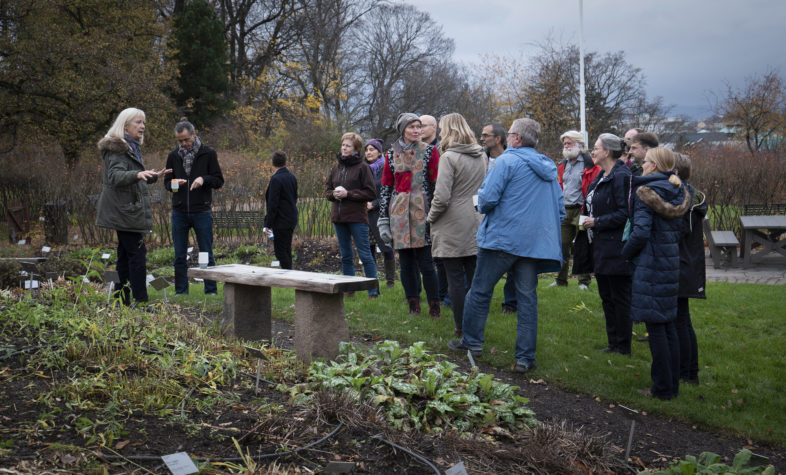Sweden
November 23, 2021
We need to make the concept of crop wild relatives better known and include these important plants in management plans for protected areas. These are two important conclusions that were drawn recently during a stakeholder workshop in Oslo.
Climate changes brings us difficult challenges, not least when it comes to agriculture and future food security. The crop wild relatives (CWR, wild plant species closely related to cultivated crops) can be very important in plant breeding to develop new agricultural crops that are more resistant to drought, waterlogging or various forms of pests.
NordGen coordinates a four-year project on CWR in the Nordic countries. As part of this project, a stakeholder workshop was recently arranged at the Natural History Museum in Oslo. About 40 people participated on site or online for two days with presentations, guided tours, group discussions and brainstorming.

Anna Palmé, NordGen’s project coordinator and expert on CWR.
– It has been a couple of very rewarding and eventful days that really show the importance of working together across national borders on these issues. The CWR project is a good example of pan-Nordic collaboration, said Anna Palmé, project coordinator and NordGen’s plant expert on CWR in the Nordic region.
On site in Oslo, project partners from all the Nordic countries participated. Parts of the program included presentations about the progress of the CWR project. During the summer, inventories and collection of seeds from CWR were carried out in several places in the Nordic region (see fact box below).
Rich Biodiversity
In Iceland, the summer work was focused on Vatnajökull National Park, an area that covers 15 percent of the country and includes natural birch forest, old meadows, mountains and desert areas with sand dunes. When seeds are to be collected, many individuals from a population are required to get a correct representation of the genetic diversity within the population. Magnus Göransson, an independent researcher in Iceland, talked about the challenge of collecting seeds from alpine bluegrass (Poa alpina), a grass that is related to Kentucky bluegrass (Poa pratensis) which is used as forage and in lawns.

Magnus Göransson is involved in the Nordic CWR project.
– Alpine bluegrass grows on large areas but not densely, so the challenge was to find sufficiently large populations, also in dry areas because that is where they produce seeds. Timing is also important since the grass releases the seeds when matured, said Göransson.
In Norway, activities were carried out in Færder National Park, an area with rich biodiversity, which consists of about 80 islands in the archipelago south of Oslo.
 The wild sand cat’s-tail (Phleum arenarium) is related to the important forage timothy grass (Phleum pratense). This photo was taken in Færder National Park by Oddvar Pedersen.
The wild sand cat’s-tail (Phleum arenarium) is related to the important forage timothy grass (Phleum pratense). This photo was taken in Færder National Park by Oddvar Pedersen.
– During the summer, inventories were carried out on seven islands where we found 51 species of CWR, which corresponds to about 50 percent of the species on the Nordic priority list. An important aspect is that CWR are recognized in the area’s management plan, said Linn Borgen Nilsen, senior advisor at the Norwegian Genetic Resource Center/NIBIO.
Increased Knowledge
Including CWR in management plans and other control documents is an important step in the conservation work. Jens Weibull, Senior Officer at the Swedish Board of Agriculture, talked about the situation in Sweden.
– As far as I know, there is only one Swedish protected area where genetic diversity is mentioned as ground for protection. The whole idea of conserving biodiversity has not been implemented. This is very much a communications task, the concept of CWR must become more well known, said Weibull.
The need to increase the knowledge about CWR, both among the general public, decision-makers and nature conservation staff, was repeated in several of the presentations.
– In Norway, we have a long way to go to spread the knowledge, among the general public but also within the university world and the field of nature management, said Kristina Bjureke, lecturer at the Natural History Museum in Oslo/Oslo University.
 During the workshop, Kristina Bjureke gave a guided tour for the participants.
During the workshop, Kristina Bjureke gave a guided tour for the participants.
Statement by the Minister
In addition to workshop participants from the Nordic countries, representatives from Germany, Spain and the United Kingdom participated in Oslo. Imke Thormann, Senior Officer for Plant Genetic Resources at the German Federal Office for Agriculture and Food, talked about the establishment of a genetic reserves for wild celery in Germany. A presentation about experiences with legislation was given by researcher Shelagh Kell from the University of Birmingham. José Iriondo, Professor at the Universidad Rey Juan Carlos in Madrid, spoke about the development of the Spanish national strategy for CWR. His advice for overcoming bureaucratic obstacles was summarized as follows:
– Be patient, be persistent, be resilient and creative.
Back to the realization that knowledge about CWR needs to be disseminated. The workshop ended in a positive way when a news article began circulating among the participants. In connection with the workshop, Norway’s new Minister of Food and Agriculture, Sandra Borch, made a statement:
– We do not know today exactly which genetic resources that may be useful in the future. Therefore, there is a need for a rich reservoir, and it includes the wild relatives of cultivated plants.
FACTS: Activities within the Nordic CWR project
Climate change modelling of the geographic distribution of CWR species.
In-depth inventories to determine presence and status of CWR populations in selected sites (protected areas).
Collect seeds of selected CWR species for conservation at NordGen.
Evaluate the genetic diversity of selected CWR species across the Nordic region (using molecular markers).
Workshops and meetings: stakeholder workshops 2021 and 2023, final seminar 2024.
Communication: short films, plant portraits, travelling exhibition, scientific papers, policy brief and report etc.